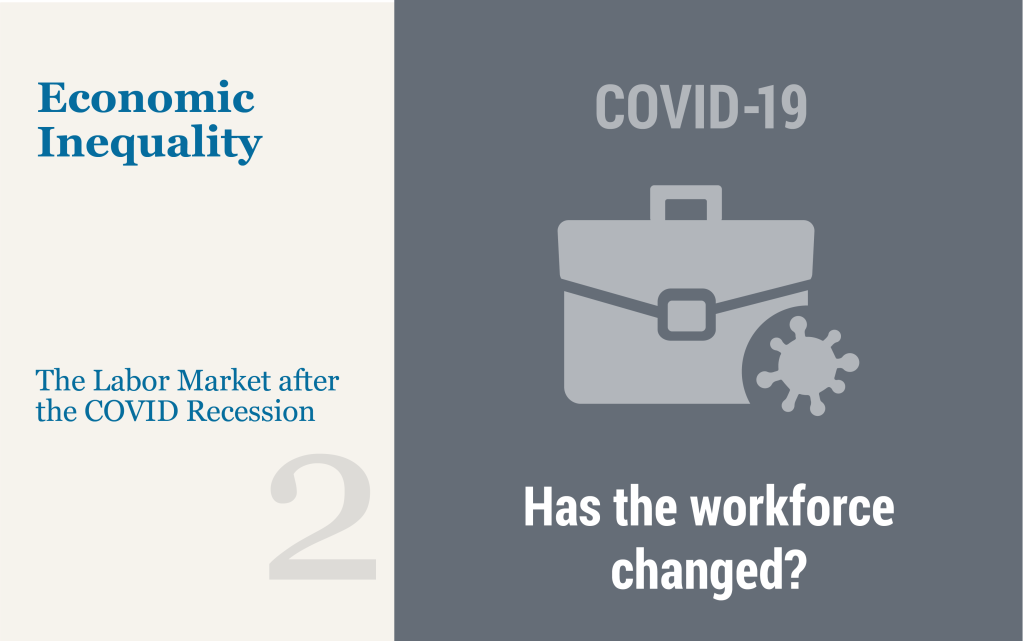Federal Reserve System Conference on the Financial Stability Considerations for Monetary Policy

How does monetary policy affect financial vulnerabilities and, in turn, how does the state of the financial system interact with the maximum employment and price stability goals of monetary policy? These were the key questions covered in the September 30 conference organized by the Federal Reserve System. The conference was co-led by Federal Reserve Board Vice Chair Lael Brainard and Federal Reserve Bank of New York President and CEO John C. Williams, each of whom offered prepared remarks. The program also included a panel of current and former central bank policymakers to explore the themes of the conference, as well as paper presentations with discussants. In this post, we discuss highlights of the conference. The agenda includes links to all of the presentations as well as videos for each session.
Long COVID Appears to Have Led to a Surge of the Disabled in the Workplace

Although most of those infected with COVID-19 have recovered relatively quickly, a substantial share has not, and remains symptomatic months or even years later, in what is commonly referred to as long COVID. Data on the incidence of long COVID is scarce, but recent Census Bureau data suggest that sixteen million working age Americans suffer from it. The economic costs of long COVID is estimated to be in the trillions. While many with long COVID have dropped out of the labor force because they can no longer work, many others appear to be working despite having disabilities related to the disease. Indeed, there has been an increase of around 1.7 million disabled persons in the U.S. since the pandemic began, and there are close to one million newly disabled workers. These disabled workers can benefit from workplace accommodations to help them remain productive and stay on the job, particularly as the majority deal with fatigue and brain fog, the hallmarks of long COVID.
What Have Workers Done with the Time Freed up by Commuting Less?

The COVID-19 pandemic has dramatically changed the way Americans spend their time. One of the most enduring shifts has occurred in the workplace, with millions of employees making the switch to work from home. Even as the pandemic has waned, more than 15 percent of full-time employees remain fully remote and an additional 30 percent work in hybrid arrangements (Barrero, Bloom, and Davis). These changes have substantially reduced time spent commuting to work; in the aggregate, Americans now spend 60 million fewer hours traveling to work each day. In this post, we investigate how people spend this saved time on other activities. Using detailed data from the American Time Use Survey (ATUS), we find that employed individuals allocate their saved commute time toward leisure activities and sleeping, while reducing overall work hours.
What Is the Outlook for China’s External Surplus?

The sharp slowdown in China’s property sector has reignited debate over the country’s future role as a net provider of savings to the global economy. The debate revolves around whether a sustained decline in property investment will spur a long-term increase in China’s current account surplus, given the country’s high savings rate. However, China’s rapidly aging population presents opposing forces that complicate this story. The shift of a large share of its population from working life to retirement will reduce savings supply even as a shrinking labor force will reduce investment demand. In this post, we focus on the demographic part of the story and find that this force will exert considerable downward pressure on China’s current account surplus in coming years.
With Abundant Reserves, Do Banks Adjust Reserve Balances to Accommodate Payment Flows?

As a result of the global financial crisis (GFC), the Federal Reserve switched from a regime of scarce reserves to one of abundant reserves. In this post, we explore how banks’ day-to-day management of reserve balances with respect to payment flows changed with this regime switch. We find that bank behavior did not change on average; under both regimes, banks increased their opening balances when they expected higher outgoing payments and, similarly, decreased these balances with expected higher incoming payments. There are substantial differences across banks, however. At the introduction of the abundant-reserves regime, small domestic banks no longer adjusted balances alongside changes in outgoing payments.
New SCE Charts Include a Measure of Longer‑Term Inflation Expectations

Today, the New York Fed introduces several new data series and interactive charts depicting findings from its Survey of Consumer Expectations (SCE). The SCE is a representative, internet-based monthly survey of a rotating panel of about 1,300 household heads in the United States. Since January 2014, we have been reporting findings from our monthly survey on U.S. households’ views on inflation, household income and spending growth, their expectations about the housing and labor market, and a range of other expectations about the economy and outcomes for their own household. In addition to publishing interactive charts showing national trends as well as trends by demographic groups (such as age, income, education, numeracy, and geography), we also post the underlying microdata online (with a nine-month lag) to make it available for research purposes. We are adding three new data series to our interactive charts today. The first two concern expectations about future inflation, and the third concerns expectations of future home price growth.
Computer Saturation and the Productivity Slowdown

One of the current puzzles in economics is the recent worldwide slowdown in productivity, compared to the late 1990s and early 2000s. This productivity loss is economically large: if productivity growth had stayed at the same level as in 1995-2004, American GDP would have increased by trillions of dollars. In this post, I discuss a new paper that links this productivity slowdown to saturation in electronics adoption across most industries. I show that most of the productivity growth from electronic miniaturization is concentrated between 1985 and 2005.
Measuring the Ampleness of Reserves

Over the past fifteen years, reserves in the banking system have grown from tens of billions of dollars to several trillion dollars. This extraordinary rise poses a natural question: Are the rates paid in the market for reserves still sensitive to changes in the quantity of reserves when aggregate reserve holdings are so large? In today’s post, we answer this question by estimating the slope of the reserve demand curve from 2010 to 2022, when reserves ranged from $1 trillion to $4 trillion.
Eviction Expectations in the Post‑Pandemic Housing Market

Housing is the single largest element of the typical household’s budget, and data from the SCE Household Spending Survey show that this is especially true for renters. As the housing market heated up in the latter stages of the pandemic, home prices and rents both began to rise sharply. For renters, some protection from these increases was afforded by national, state, and in some cases local eviction moratoria, which greatly reduced the risk of households losing access to stable housing if they couldn’t afford their rent. Yet many of these protections have expired and additional supports will do so soon. In this post, we draw on data from our SCE Housing Survey to explore how renters perceive their housing risk and find that the answers depend to a large degree on their current and past experiences of the housing market.











 RSS Feed
RSS Feed Follow Liberty Street Economics
Follow Liberty Street Economics